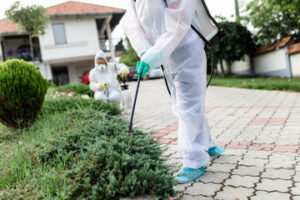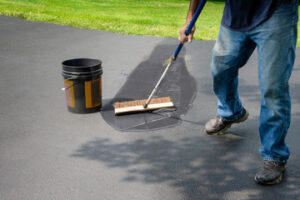Kansas City Pest Control services help safeguard public health by eliminating disease-carrying pests like rodents, insects, and birds. These services use a combination of methods like sanitation, exclusion, and monitoring to keep pests out and prevent infestations from recurring.

Preventive pest management includes regularly scheduled inspections and sealing entry points to create a less welcoming environment for pests. This minimizes pest-related damage to structures and improves occupant comfort.
Prevention
Pests have a variety of negative impacts on property, health, and safety. Some are frightening or grotesque in appearance (like rodent droppings, spider webs, and bee hives), while others bite or sting (like ticks, flies, fleas, cockroaches, and ants). Pest infestations may cause disease and contaminate food (like mice, rats, and cockroaches) or pose health risks through their contact with people and animals (like flies, earwigs, bees, wasps, ants, rodents, and other pests).
Pest damage can reduce a property’s value and make it unattractive to prospective buyers or renters. For example, termites can damage the structure of a home, and carpenter ants can chew through electrical wiring and insulation. Effective preventative pest control measures can keep these threats at bay and maintain a home’s value.
Preventative pest control services include regular inspections and treatment before a problem develops. These preventative services are often less expensive than reactive treatments. In addition, they can help you avoid the cost and inconvenience of dealing with a major pest infestation.
Suppression is a key objective of pest control, and it involves reducing the number of pests to an acceptable level. This is accomplished through a variety of methods, including biological, physical, and chemical controls. Biological methods involve the use of predators, parasites, and pathogens to keep pest populations below unacceptable levels. Physical and chemical control techniques include exclusion, trapping, and spraying.
It’s important to note that responsibility for pest control in residential buildings can vary based on the individual situation. In general, building owners and managers are responsible for maintaining a habitable environment. However, some states place the responsibility on residents to report pest problems and take appropriate preventative measures. This is why it’s important to clearly outline responsibilities in lease agreements between building owners and tenants.
Proper pest control is a critical aspect of maintaining a safe, sanitary property and preserving its value. Preventative pest control measures are an excellent way to keep a property free of destructive bugs and other nuisances that can lead to costly repairs and reduce its overall value.
Detection
Pest infestations carry hidden costs that extend far beyond initial extermination fees. For example, termites can silently erode the integrity of buildings, leading to expensive repairs and creating health hazards. Rodents can chew through insulation and electrical wires, escalating energy bills and posing fire risks. Dust mites, cockroaches, and other pests trigger allergies and asthma, increasing medical expenses. Moreover, uncontrolled pest populations can devalue property and reduce marketability.
Regular inspections and proactive pest control measures can significantly reduce these hidden costs. However, even the most pristine homes can experience infestations because pests are drawn to food sources, water, shelter, and warmth. Inadequate sanitation practices, failure to seal entry points, and failure to address issues like leaking pipes or dripping faucets can provide pests with easy access to these resources.
Hiding places and undisturbed areas are also common habitats for pests. Finding droppings, urinating, or gnaw marks in and around the home can indicate pest activity. Inspecting cluttered spaces and piles of debris, as well as checking for cracks in walls and dripping roofs can help identify possible pest hiding spots.
Detecting pests early and responding promptly to their presence can prevent them from spreading and causing more damage. Infestations that go undetected or are ignored often grow out of control, necessitating more extensive and costly treatments and posing a greater risk to people’s health and safety.
Monitoring indoor and outdoor areas for insect, insect-like, mollusk, and vertebrate pests usually involves scouting or trapping. The goal of monitoring is to determine whether or not the pest population has reached threshold levels that warrant control. Eradication is rarely a viable goal in outdoor pest situations, but prevention and suppression are usually preferred approaches.
Maintaining a clean and sanitary environment, sealing entry points, and practicing good garden hygiene can significantly lower the likelihood of a pest infestation. However, even the most pristine homes may experience pest problems because of factors that go beyond their control. Professional pest control services can use their expertise, specialized tools, and comprehensive training to quickly identify, target, and eradicate pest infestations.
Suppression
Pest control services help property managers create a comfortable and healthy living environment for residents. They also protect and preserve property values by reducing the risk of damage from pests. By regularly inspecting and treating properties for pests, they nip potential critter problems in the bud before they grow into major infestations that are difficult and costly to eradicate.
Many organisms are considered pests because they interfere with human activities, cause diseases, or spoil food, materials, and property. There are various methods of controlling pests, including exclusion or quarantine, repulsion, physical removal, and chemical controls. The choice of control measures depends on the type and severity of the problem, as well as environmental considerations.
Preventive pest control services include trimming overgrown plants, keeping trash bins covered and emptied, sealing cracks and crevices, modifying irrigation practices, and providing recommendations for minimizing attractants. These methods are less invasive and require fewer chemicals than conventional pesticides. They are usually incorporated into an integrated pest management (IPM) program and can be used in combination with other preventive strategies.
Some organisms, such as mites that feed on mite pests in orchards and parasitic nematodes that kill harmful soil grubs, are natural enemies of certain pests and can be conserved or released to keep their populations under control. Other organisms that naturally occur, such as fungi that control plant diseases or the beneficial bacteria that suppress pathogenic fungi in rice, can be introduced to reduce pest populations.
Chemical control includes the use of a broad range of pesticides to destroy weeds, insects, and rodents. The type and amount of pesticide to use are determined by scouting and monitoring, as well as the specific characteristics and needs of the property being managed.
Pest control services can help prevent the damage and destruction that often results from a pest infestation by eliminating the pests before they can do any significant harm. Regular pest inspections and treatments can also save money in the long run by preventing the need for extensive and expensive repairs or replacements. In addition, pest infestations can lower a property’s resale value and make it more difficult to sell.
Treatment
A pest infestation threatens health and safety, detracts from the property’s value, and can increase maintenance costs. Professional pest control services offer effective treatments that minimize damage and prevent future infestations.
A regular inspection by a qualified pest control technician is the most effective prevention strategy. A thorough inspection will identify entry points, signs of pest activity, and the type and severity of the infestation. An experienced pest control expert can create a customized treatment plan based on the findings of this inspection.
Many pests, such as termites, ants, and rodents, are destructive and cause costly damage to buildings and materials. Pest control services quickly respond to any invasive pests, protecting the integrity of the building structure and saving on repair costs. In addition, pests such as cockroaches and bed bugs spread disease-causing pathogens and allergens that can pose serious health risks. Prompt pest control measures thwart these health threats, preserving food supplies and eliminating the need for pricey replacements.
Regular pest inspections also help reduce costs by preventing severe infestations. Pest control services can provide preventative treatments, such as spraying, baiting, or trapping, to eliminate existing pests and keep them away for good. These treatments may also include identifying and sealing entry points to prevent pests from returning after the initial treatment.
Pest prevention strategies should focus on reducing the conditions that promote pests, such as providing proper sanitation and food storage practices. Organizing shelving and cabinets, sealing loose food items, and limiting clutter can help reduce the conditions that promote pests in storage areas. In addition, a sanitary environment with clear lines of sight is more easily inspected for signs of pests and easier to clean.
Preventative pest control is less expensive than a complete pest infestation and is often more effective than remedial or eradication treatments. For example, a single roach infestation can take months to eradicate with a DIY approach, while a cockroach extermination service is quicker and more effective. Moreover, professional pest control services are familiar with local regulations and building codes, and they can ensure that their preventative treatments comply with these requirements.

